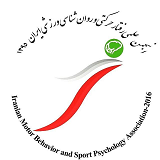Thu, Dec 25, 2025
[Archive]
Volume 2, Issue 4 (11-2020)
IJMCL 2020, 2(4): 41-45 |
Back to browse issues page
Download citation:
BibTeX | RIS | EndNote | Medlars | ProCite | Reference Manager | RefWorks
Send citation to:



BibTeX | RIS | EndNote | Medlars | ProCite | Reference Manager | RefWorks
Send citation to:
Nazemzadegan G H, Yousefi M. (2020). The Effect of Explicit and Implicit Learning on Static Balance. IJMCL. 2(4), 41-45. doi:10.29252/ijmcl.1.2.41
URL: http://ijmcl.com/article-1-43-en.html
URL: http://ijmcl.com/article-1-43-en.html
Assistant Professor, Department of Behavioral Sciences, Faculty of Educational Sciences and Psychology, Department of Sport Sciences, Shiraz University, Shiraz, Iran , ghnazem@gmail.com
Abstract: (5497 Views)
Objective: The purpose of this study was to investigate the effect of learning type on balance.
Methods: For this purpose, 80 female students aged 9-12 years who were selected by random cluster sampling and after Flamingo test, they were divided into two groups randomly: explicit learning and implicit learning. The subjects were required to maintain balance on the Stabilometer. The acquisition stage included 24 attempts 60 seconds. Explicit learning groups received feedback while on the device, but the implicit learning group was required to perform a secondary cognitive task in addition to maintaining a balance without receiving feedback.
Results: Analysis of covariance with a significant level of р≤ 0.05 showed that there was no significant difference between explicit and implicit learning in static balance.
Conclusion: The results indicate that the subjects of both groups had improvement in their post-test balance records compared to the pre-test. Therefore, probably the static balance with regard to its subcortical mechanism cannot be influenced by the type of learning.
Methods: For this purpose, 80 female students aged 9-12 years who were selected by random cluster sampling and after Flamingo test, they were divided into two groups randomly: explicit learning and implicit learning. The subjects were required to maintain balance on the Stabilometer. The acquisition stage included 24 attempts 60 seconds. Explicit learning groups received feedback while on the device, but the implicit learning group was required to perform a secondary cognitive task in addition to maintaining a balance without receiving feedback.
Results: Analysis of covariance with a significant level of р≤ 0.05 showed that there was no significant difference between explicit and implicit learning in static balance.
Conclusion: The results indicate that the subjects of both groups had improvement in their post-test balance records compared to the pre-test. Therefore, probably the static balance with regard to its subcortical mechanism cannot be influenced by the type of learning.
Type of Study: Original Article |
Subject:
2. Motor control
Received: 2020/07/18 | Accepted: 2020/10/19
Received: 2020/07/18 | Accepted: 2020/10/19
References
1. Abdoli, B., Ashayeri, H., Bagherzadeh, F., & Farrokhi, A. (2004). Comparison of the effect of hidden and explicit learning on chain reaction time. Motion Magazine, 19.
2. Bond, K. M., & Taylor, J. A. (2015). Flexible explicit but rigid implicit learning in a visuomotor adaptation task. Journal of neurophysiology, 113(10), 3836-3849. [DOI:10.1152/jn.00009.2015]
3. Maxwell, J. P., Capio, C. M., & Masters, R. S. (2017). Interaction between motor ability and skill learning in children: application of implicit and explicit approaches. European journal of sport science, 17(4), 407-416. [DOI:10.1080/17461391.2016.1268211]
4. Nejati, Vahid, Izadi Najafabadi, Entezari. (2014) Comparative study of explicit and implicit motor learning of dominant and non-dominant hand in young people. Jundishapur Medical Journal (12) 2, 187-177.
5. Orrell, A. J., Eves, F. F., & Masters, R. S. (2006). Implicit motor learning of a balancing task. Gait & posture, 23(1), 9-16. [DOI:10.1016/j.gaitpost.2004.11.010]
6. Shea, CH., Wulf, G., Whitacre, CA. and Park, JH. (2001). Surfing the implicit wave. The Quarterly Journal of Experimental Psychology: Section A. 54(3):841-62. [DOI:10.1080/713755993]
7. Shumway-Cook, A., & Woollacott, M. H. (2001). Theory and Practical Applications.
Send email to the article author
| Rights and Permissions | |
 |
This work is licensed under Attribution 4.0 International (CC BY 4.0). |












